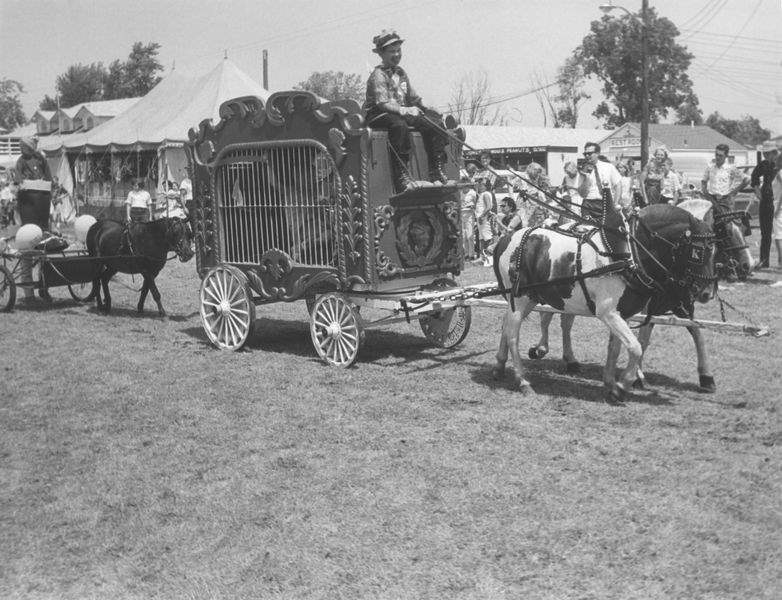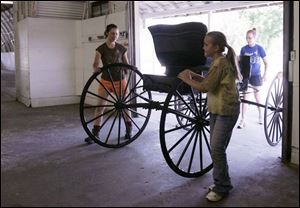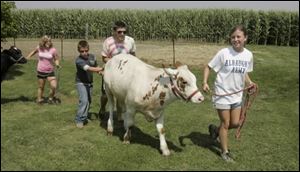
Lucas County Fair marks its 150th year
7/20/2008
A circus wagon navigates the grounds during the 1965 Lucas County Fair. The fair moved from Dorr Street in Toledo to its present location in Maumee then Adams Township in 1917.
BLADE/LLOYD RANSOM

Anthony Wayne Trailblazers 4-H club members Sarah Matesz, left, Elizabeth Wolf, center, and Valeri Wolf push a 1900s carriage into a barn for the fair. About seven carriages will be on display and will also be used for horse shows.
As county fairs go, the one that kicks off its 150th year this week in Lucas County is not the biggest, oldest, or most well-attended in northwest Ohio.
Yet one unique distinction the Lucas County Fair could claim is that it is the region s most urbanized: farmland surroundings long gave way to subdivisions of houses and apartments; the family barn became a two-car garage.
And being what insiders call a city fair is not so beneficial for bringing in large numbers of agricultural and livestock exhibits two enduring mainstays of county fair culture.
When it comes to attendance numbers, a sore spot in recent years, the fact of the matter for fair board President Dave Pruss is there are now too many other nearby festivals and summer events for the fair to capture attention as it did in yesteryear.

Cori Plocek, 18, far right, practices walking a fair animal at her home in Monclova Township in preparation for the Lucas County Fair. She is joined by, from left, Brianna Binkley, 14, and Nathan Barney, 8, both of Monclova, and Kevin McCartney, 18, of Swanton.
The fair attracted more than 100,000 annual visitors in the early 1980s. Last year, it drew about 40,000.
In contrast, the rural Fulton County Fair counted a record 281,091 visitors last year when its own 150th anniversary celebration dominated local community calendars.
Back then you didn t have all the entertainment in the Toledo area going on, Mr. Pruss said. It s rough competition when you re in a city fair.
But city-slicker life hasn t dampened hopes this year in Lucas County for a successful six-day fair that will educate and amuse both spectators and exhibitors and hopefully keep finances out of the red.
Mr. Pruss predicted the determining factor for turnout will again be the weather, since rain could keep tens of thousands of people at home.

A circus wagon navigates the grounds during the 1965 Lucas County Fair. The fair moved from Dorr Street in Toledo to its present location in Maumee then Adams Township in 1917.
The Lucas County Agricultural Society, which operates as the fair board, also hopes to draw a larger crowd for this year s 150th anniversary.
Back in time
As far as is known, the fair has been held almost every year since 1858 and in at least four locations.
The only break in the annual tradition occurred in 1917, the year the fair board sold its location in present-day central Toledo to buy the fairgrounds in Maumee off Key Street in what at the time was Adams Township.
Nearly half a century later, a story in The Blade explained the mystery of this missing fair, which by then was causing much confusion.
The article quoted L. Wade Fullington, the 1964 fair manager, on his recent discovery in the record books that there was no money left in 1917 after the Lucas County Agricultural Society finished making payments on the 122-acre Maumee land and had built its grandstand, so the fair was postponed a year.
The new site was known as Fort Miami Fairgrounds, and contained a horse-racing track that remained popular for decades during weeks of the year between the fair. In 1929 it became the first horse track in the country to install night lighting.
Yet by the early 1960s, auto racing had moved to Toledo Speedway and harness racing to Raceway Park.
The county soon took control of the fairgrounds and built the Lucas County Recreation Center, which, in 1965, became home to the Toledo Mud Hens in Ned Skeldon Stadium.
Today, the fair board rents about 40 acres of the original grounds year round and during fair week gains control of the full site, Mr. Pruss said.
Through the decades, musical acts, and entertainment have come and gone. The more eccentric have included a greased-pig contest, a strong-man competition, and the 1976 visit by a traveling miniature White House.
For this year s event, nearly 250 livestock have been signed-up, more than 140 fair vendors are registered, and there should be 15 different mechanical rides for visitors, fair officials said. The fair budget is about $275,000.
Urbanized counties
In addition to Lucas County, other urbanized counties in the state face similar challenges come fair season.
David Stephan, board president of the Cuyahoga County Fair, which includes Cleveland, said residents in and around cities have so many entertainment options they are not as inclined as those in rural areas to consider the fair as a big yearly event.
Nevertheless, Mr. Stephan said his fair manages to bring in between 150,000 and 180,000 people during a year with good weather. And to compensate for the lack of farms in the Cleveland area, the fair pays farmers in other parts of the state to show their livestock at the Cuyahoga County Fair.
In Lucas County, though, with declining attendance came occasional money troubles during the 1980s and 1990s. To raise revenue, the fair started selling beer.
A loss of tradition
Today some veteran fair-goers, such as Peggy Brown, an adviser for the Anthony Wayne Trailblazers, a 4-H group, believe the event has lost touch with its roots.
It s become more of a carnival atmosphere, said Mrs. Brown of South Toledo, who has been involved in the fair for nearly 40 years. The saddest thing is the fewer animals and less emphasis on the agricultural elements.
For Mrs. Brown, this decline gained speed about 25 years ago following the demolition of an old animal showing barn.
The building s replacement, Recreation Hall 2, was built to accommodate show animals but has never been used for that purpose, Mr. Pruss said.
Another longtime 4-H volunteer, Vicki Ryan of Monclova Township, said the animals that do appear at the fair are often exceptional.
We don t have as many livestock at our fair, but we do have quality, she said. When you don t have a whole farm of animals, then if one of those kids is going to buy just two steers or two pigs, or even one pig to show, they are going to take such good care of it. So over and over again, as I ve seen the decline in the number of livestock, I ve seen the quality increase.
Mrs. Ryan said she has also seen the gender integration of 4-H and FFA groups. Girls and boys now participate in competitions once reserved for the opposite sex. Before the 1970s, for example, most female 4-H groups did homemaking skills like cooking and sewing.
Back to the country?
The newly organized Lucas County Agricultural Society had its first county fair in 1858 at the fairgrounds on West Bancroft Street in Toledo.
The August, 1871, fair was held at Put-in-Bay as a joint festival by the Lucas and Erie county agricultural societies, according to information compiled by a former fair board secretary.
Sometime in the later portion of the 1800s the date is unclear the fair moved to several dozen acres of ground in what is now central Toledo. This Dorr Street location, between Parkside Boulevard and Upton Avenue, was called the Tri-State Fairgrounds, and thousands would journey either by horse and buggy or the old Dorr Street streetcar line.
As the city s residential and industrial neighborhoods grew along Dorr Street, the fair moved to the once rural setting of present day Maumee.
Fair board officials said they would be open to moving the fair again ideally out of the city and back to the country.
If we could find someone who could give us a hundred plus acres, we probably would be out of here, fair board Secretary Kathy Wenz said.
Contact JC Reindl at:jreindl@theblade.comor 419-724-6065.